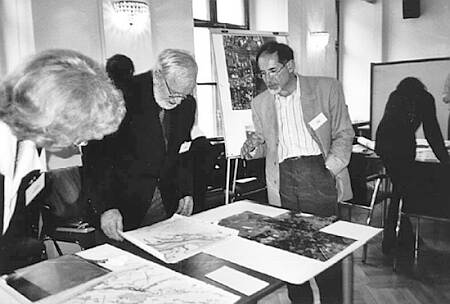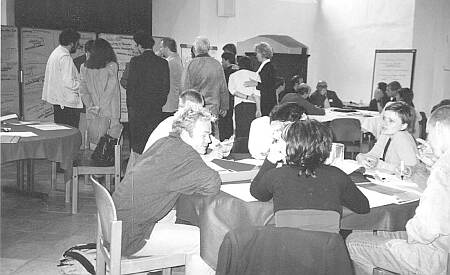COMMON LANGUAGE
A COMMON LANGUAGE FOR SPATIAL PLANNING
As the city planners already reported at the kick-off meeting, the planning practice has proven that the traditional static thinking in terms of real vs. intended condition determined by the information medium of the plan does not do justice to the complexity of reality. In the course of a traditional planning process, space is regarded static by the individual departments and then attributed to them. By doing so the aspect of ecological sustainability is by and large attached no or too little importance. However, in an ever changing world of diverse value systems, technical methods and political instruments future oriented spatial planning means working with dynamic systems. (1) This is especially true of spatial planning in the Danube region because here regions which experienced separate economic, social and cultural developments over the past five decades are cooperating and are to develop themselves organically and rather harmoniously.

In order to do justice to these challenges, the project team decided to choose a new planning approach on the basis of two examples.
-
Future search conference- planning as learning
Learning as an integral part of planning has become an important area of practice also for managers and is trained in learning laboratories (SENGE 1997:39). The future search conference is an instrument of dialogue, learning, planning and activation with which a relatively large group can plan their common future and doing so achieve unexpected breakthroughs in form of new visions. In future search conferences as many representatives as possible are brought together who focus on a common issue. The participants of the kick-off meeting articulated their problems together as a learning community instead of having an internal or external specialist provide them with a solution. The order consequently stems from initial chaos. (2)
-
The plan is the answer - but what was the question?
In the city network not only the cities but also the planning departments and universities in these cities are supposed to be interconnected. For the right bank of the Danube in Vienna, possible improvements of the bank areas, which had been redesigned in recent years, were developed. At the beginning of May 2001, students from Belgrade, Budapest, Bratislava and Vienna devised not only new models of developments but they also developed already existing ideas further.
Their main aim was that the suggestions to be made were not tasks of city planning in traditional sense but tasks and solutions in the sense of sustainable urban development. Drawing up a plan was not in the centre but a different understanding of planning is looked for to develop a better awareness of the problems of present and future questions in order that better decisions can be made.
FINDING COMMON GROUND
The project management announced to its partners that the project start be a future search conference. The central aim of the method of a future search conference is, besides planning, to work out common ground for the cooperation of participants from different sectors of society.
During the future search conference there was enough place and time to come up with visions of a common future and hatch plans for their realisation - all in all, draw as lively picture for our common process.
Finally, in mixed groups perspectives for the year 2010 were conceived out of the visions for the Danube region (3), common goals for the future were defined, and first ideas for solving hitherto unsoluble problems were worked out.(4)

(1) Cf. SCHINDEGGER Friedrich (1999): Raum. Planung. Politik. Ein Handbuch zur
Raumplanung in Österreich. Wien, Köln, Weimar: Böhlau. p. 170.
(2) Cf. SENGE Peter, M. et al. (1996): Das Fieldbook zur fünften Disziplin. Stuttgart: Klett-Cotta.
(3) See 1. Tagungsbericht BRIDGE LIFELINE DANUBE. Kick off Meeting. 4.10.-6.10. 1999 in
Krems. Schriftenreihe Freiraum. Institut für Freiraumgestaltung und Landschaftspflege.
Universität für Bodenkultur. Band 19. Wien: BOKU-IFL, p. 36-40.
(4) See 1. Tagungsbericht, p. 32-35
|
|



